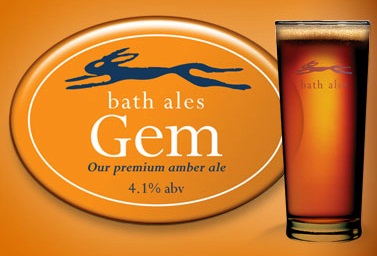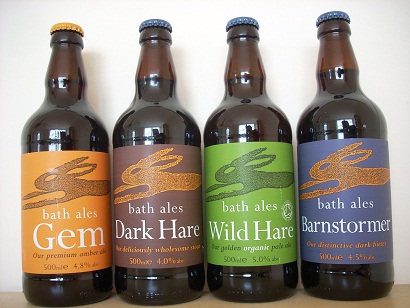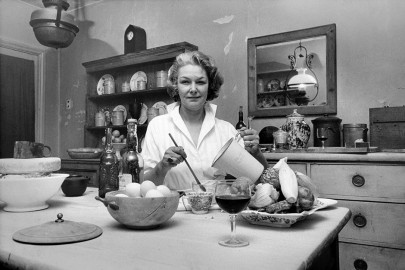The Dabbler interviews Roger Jones, the genius behind Brit’s favourite beer…
A bit tragic to admit it, but I can actually remember where I was when I had my first taste of Gem. It was 2005 and I was in the middle of a field just outside Chipping Sodbury, at, of all things, a Rotary Club beer festival. This was a relatively civilised leg of a friend’s stag weekend, and though I was rather drunk I was not so drunk that I didn’t know at once that this was a special ale. Doubtless I spent the next few hours lurching around, enthusiastically urging my fellow stags to spend their beer tokens at the Bath Ales stand.
Two things are notable about this: first, I’m no connoisseur but Gem clearly stood out in the tasting of what was, well, an awful lot of beers. Second – and this is an important clue to understanding the success of Bath Ales – I could remember the name and the logo when I woke the next morning, despite the condition of my head.
In the five years since that festival, I have consumed a fair few pints of Gem, as well as Bath Ales’ other lines which include Wild Hare – a summery pale ale – and Barnstormer, a rich, darker ale, almost rivalling Gem for ambrosial uniqueness. Also in those five years, Bath Ales’ beers have become ubiquitous in the off-licences, pubs and trendy café-bars of Bristol and surrounds, and word has begun spread across the country.
It’s always interesting to investigate what makes a particular business or product thrive in a marketplace, because the answers are informative about human nature: why do customers buy this in preference to that? Why has Bath Ales succeeded, relative to other independent micro-breweries?
Roger Jones, the company’s Managing Director, reckons that the key is that the partners are, uniquely, brewers and thus “the beer comes first.” But he is all modesty: “It is fair to say that we do not consider ourselves successful.”
That’s a tough argument to make. Founded in 1995 by former employees of Bristol’s now-defunct Smiles Brewery, Bath Ales has twice outgrown its premises, built its own bottling facility, begun retailing bottles nationally, established a shop selling T-shirts and other merchandise, and taken over nine pubs and a chophouse.
What it has never done is justify its name – all three of its plants have been in Bristol. “The original vision was to brew in Bath as a micro-brew pub serving the tourist industry. A site never came to fruition,” explains Jones. “Whilst sourcing some stainless pipe work in Bristol, one of the partners got involved with making a small brewery with some enthusiasts. The brewery was under-utilised and so space was rented to brew some ‘Bath Ales’ now and again…Once the casks were ordered, branded and banded in Bath Rugby colours, it was sort of too late to change to ‘Bristol Ales’.”
This was probably serendipitous. Bristol is a wonderful city but the name ‘Bath’ and its associations – honey-coloured stone buildings, Jane Austen, the weight of history – does convey an instant classiness. Combined with the hare logo, (“squashed rabbit”) Bath Ales has a clear and striking identity – so much cleaner and more memorable than traditional real ales, with their amateurish cartoon labelling and names like ‘Old Burt’s Gut-Rotter’.
“We did try to ‘modernise’ the image of brewers”, says Roger. “We’ve been copied by many now of course, but back in the early 90’s we genuinely were appalled by all the Malt and Hops images, and old worldly traditionalism. We wanted something that was modern and appealing to women as well as men. The hare device was always useful as a symbol of rareness, but it was the simplicity that appealed most. It translates well on t-shirts and the like.”
The Bath Ales brand does fit remarkably well into the current drinking landscape. There’s a trend generally in food and booze for the upmarket, the high-quality, the local and the ‘authentic’, and drinkers young and old who shun the anarchic Saturday night city centres now do their quaffing in faux-retro wood-and-blackboard bistros and café-bars (exemplified by the ‘Lounge’ chain that has spread all over Bristol and beyond), and foodie gastropubs.
At any rate, the company’s management understands something about the scene: Bath Ales is expanding its range of pubs at a time when, nationally, almost 30 are closing per week. “Home drinking has replaced the daily trek to the pub,” Jones acknowledges. “It has only taken 10 years and is pointedly to do with the widening price differential between the on and off trade. We recognise that people are out less often but will potentially look for special occasions to come out, so we have positioned most of the pubs with a better food offering. In fact, while we always planned to have a flagship pub, we did not actively go seeking any of the pubs we have…they sort of came to us.”
They’re also not afraid to embrace the trends that periodically sweep the industry. In 2009, a subsidiary Bath Ciders brand launched Bounders, to capitalise on the craze led by Magners and Bulmers; and this year there has even been a ‘ginger beer’. Ginger Hare sounds pretty ghastly to me and Jones admits it was a “love hate” drink, though he insists that “it was a proper beer with ginger in it, as opposed to the fermentable sugar and flavouring like Crabbies alcoholic pop.”
When I ask Jones about the process for creating such new lines, he talks about “trying to get a feel for what we see the customer wanting with a little bit of what we feel would be a challenge.”
What customers mostly want is Gem. It accounts for up to 70% of Bath Ales’ production and the company has invested in promoting it as a brand leader. But marketing-speak aside, it must be popular chiefly because of its sheer, unspeakable deliciousness.
I ask Jones if there’s a secret to the distinctive taste. He says that the inspiration was the London Pride brew of the late 1980s and early 1990s, when you could only buy it in the capital. He then launches into some fine brewer-speak: “Awful cliché but the best malt has to be used: floor malted barley and the variety has to be Maris Otter. It is useful to push the OG [original gravity] to the upper end of the scale so that the attenuation [fermentation process] can last a day or so longer and the condition can be retained. We utilise a hop with full mouth feel characteristics and try and retain a caramel element to the beer…obtained by using pure malt and no sugar derivatives.”
Staggeringly, Jones adds: “In actual fact Gem is continually criticised by CAMRA bods, as caramel is seen as an off flavour.”
Pay no attention to these CAMRA bod fools. I’ve introduced Gem to numerous beer-drinkers and they’ve all fallen in love at first sip. In any discussion of ales in the area formerly known as Avon, Gem will inevitably come up, with many a moan of yearning. I suggest it is this word-of-mouth about Gem that has ensured Bath Ales’ success. And though Roger Jones of course denies that they’ve actually had any success, he will allow that “at least to some extent we have established Gem as a product customers seem to like.”
Now there’s an understatement. The Gem formula is pretty simple, though achieving it is immensely difficult: create a delicious, distinctive beer with a strong, distinctive brand. I’ve been ‘seeming to like’ absolutely gallons of the stuff for the last five years.
You can subscribe to Bath Ales newsletter here, and even follow them on Facebook and Twitter.












I’ve introduced Gem to numerous beer-drinkers and they’ve all fallen in love at first sip. Love it, love it, love it, Mr Jones sounds like a person of considerable depth, a micro brewery not run by Morris dancer clones. Pray tell me kind sir, is the nectar available north of Carter Bar?
The big supermarkets might have one, probably Gem, Malty. Otherwise you can buy via their website. You’d have to pay delivery of course but they charge it at cost.
I love gem! So many bottled ales in the supermarket are too hoppy for me and taste kind of like sweaty armpits! Gem is so lovely and smooth- pure nectar! Malty, I buy gem in my local sainsburys here in the midlands, hopefully they’ll stock it up there too!
A post to make an ex-pat drool into his cornflakes! I never tried any of their beers, but London Pride was always a favourite. Interestingly (for me), our city’s mighty Ursus Brewery (now owned by the British SAB Miller plc) is being closed down; they’re continuing production of Ursus lager elsewhere, but the landmark city centre site will apparantly be refurbished to include a micro-brewery – oh yes.
Will make a point of trying this next time I’m back home. Love their branding. Would almost certainly try it on those grounds alone if I came across it on the supermarket shelves.
Is it better than beers from St Peter’s?
I can find that in an Edinburgh Waitrose and it is very fine.
worth gearing up for chaps?
Ian, where St Peter’s is dry and hoppy, Gem is sweet and caramel-y. (Whisper it, but I agree with CAMRA: I prefer a more fragrant pint, such as Hooknorton or Tim Taylor).
Ever heard of something called strategy, Gaw?
Yes – do you think Hooknorton read this blog?
I’ve thought about it more and I think what it is about gem is that many good beers taste sweet and nutty and lovely in the pub, but a lot harsher from the bottle, whereas gem seems to taste just like a perfect pub pint, and all in the comfort of your own sitting room.
So maybe it’s gem’s fault that all our pubs are closing down
The comments are interesting and perhaps some perspective would help. The introduction of mass process control changed beer as it did many foodstuffs, the end product was a result of the process machineries requirements, and of course the Aussies dumped their revolting liquid on us. Prior to that the quality of good beer depended upon how well the landlord kept it, I know a pub in Elsdon where the wooden kegs were kept under turf in the cellar to maintain temperature. Even prior to automation good beers were few, in the south Courage Directors, some Watney’s and Worthington’s. Fremlin’s was utter crap as was Greene King. Tyneside had Newcastle Exhibition and McEwan’s Special but only when kept well. Scottish beer was and is undrinkable.
Whilst all of this was happening the Germans carried on as normal protected by the purity laws, the Reinheitsgebot although recently they have been incorporated into the alcohol taxation system so who knows. They of course taught the Chinese how to brew and the reason for some very good beers.
Then along came the microbrewery, real are having been around for a long time and the roller coaster started, every latter day arts and crafts wannabe started up then went tits up, there are just as many microbreweries turning out winklewash as there are from the big boys. Why even the old Alcan Aluminium works in KInlochleven is now a brewery, and ice climbing wall, even I, the quiet one, have a Beer named after my great great grandfather, the one who knocked off a magistrate but didn’t.
So…beer, objective / subjective, the good stuff is..the good stuff, the rest, indifferent or bad. I use 25 year old Macallan or Bruichladdich as the control for whisky, Lowenbrau Oktoberfest and Früh Kölsch for beer, if yer Gem is in that ball park I shall rejoice.
I stopped drinking beer in the UK in about 1970, it was so bad.
One more (important) thing, price. In Britain we are ripped off alarmingly when buying beer, who’s fault that is I am not interested in. I buy 20x500Ci of excellent beer for 13 to 15 Euro’s in Germany, I get money back off the bottles and the crate. Similar beer in Tesco is £1.45 each for 500Cl Microbrewery beer is even more expensive. Unless it can significantly lower its costs the industry will never reach a significant mass And remain at Fred in the Shed status.